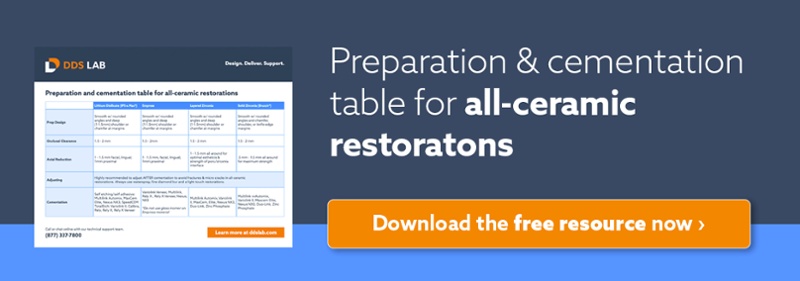Clinicians have a wide variety of options when selecting direct and indirect restorative materials. When considering suitable possibilities, clinicians must consider the size and location of the restoration, the patient’s chewing habits, and their level of oral hygiene and maintenance.
Indirect Restorative Materials
Indirect restorative material choices include all-ceramic, porcelain-fused-to-metal, cast-gold and cast-metal.
All-Ceramic
All-ceramic materials create natural, lifelike restorations with excellent translucency using the most advanced ceramics currently available. These factors help to provide highly esthetic restorations, and this material is resistant to wear due to the natural hardness of ceramics. All-ceramic restorations are highly biocompatible, but they do rely on technique-sensitive cement and adhesives to bond them in place and to ensure the tooth is properly sealed against leakage. Restorations may be made from zirconia or from pressable ceramics such as IPS e.max or IPS Empress. When fabricated from zirconia, these restorations can be 100% pure zirconia or layered with compatible porcelains. All-ceramic restorations are suitable for crowns, inlays, onlays, veneers, and dental bridges.
Porcelain Fused to Metal
Porcelain-fused-to-metal (PFM) crowns and bridges have been successfully used for decades. The restorations are fabricated by fusing porcelain to a metal framework. PFMs have a high supportive strength that is suitable for posterior teeth and for multiple unit bridges. The underlying metal is masked by porcelain. When choosing this type of restoration, it’s important to consider the metal alloy, as generally high noble alloys are more easily tolerated by patients. One major drawback of using PFM crowns and bridges is that this type of restoration sometimes cannot provide the high level of esthetics that is achievable with all-ceramic restorations. Over time, gum recession may expose the margin of a PFM creating an undesirable gray line. Additionally, it can sometimes be difficult to successfully mask the underlying metal framework when creating anterior restorations, particularly in comparison with all-ceramic restorations.
Cast-Gold Alloys
Cast-gold alloys are durable and biocompatible and their relatively high strength allows for minimal reduction of tooth structure so thinner restorations can be created. They will not wear down opposing natural teeth and are long-lasting, and it is rare for patients to have an allergic reaction to gold. Gold alloys include non-noble metals, which help improve their strength. Visibility is their biggest disadvantage but cast gold alloys can be good for creating smaller restorations in locations where they cannot be seen under normal circumstances.
Direct Restorative Dental Materials
Direct restorative dental materials include amalgam, resin-based composite, glass ionomer, resin modified glass ionomer and acrylic.
Amalgam
Amalgam is a mixture of mercury and silver alloy that is extensively used for restoring posterior teeth. It is good for large, load-bearing restorations but does require extensive removal of tooth structure to ensure adequate retention and thickness of the filling. Amalgam is highly resistant to wear but can be brittle. Aesthetically, amalgam is highly visible, and an increasing number of dental offices are now amalgam-free due to concerns about the mercury content and because of the introduction of newer and more biocompatible direct fillings.
Resin-based Composite
Made from a mixture of glass filler and acrylic, composite resin creates a highly esthetic filling and may also be used for veneers. It is good for small to moderate-size restorations and its adhesive qualities allow for minimal tooth preparation. Composite resin mimics natural tooth color and translucency, although it can become discolored over time.
Glass Ionomer
Glass ionomer is made from a self-hardening mixture of glass powder and fluoride. It will slowly release fluoride, creating better oral health. It is generally used in non-load-bearing restorations, as the material has low resistance to fracture. Glass ionomer creates a natural-looking restoration but it lacks the translucency of enamel.
Resin-Modified Glass Ionomer
Resin-modified glass ionomer consists of glass filler, fluoride, glass powder, and acrylic resin. Like basic glass ionomer, it also releases fluoride. Resin-modified material has a better resistance to fracturing than glass ionomer but is best used in non-load-bearing restorations.
Please be reminded that our experienced technical team is here to assist you should you wish to discuss a case in more detail.
Click here to schedule a consultation with our technical team »

References:
http://mckeedental.com/pdf-brochures/fillingmaterials.pdf
http://www.dentalcompare.com/Restorative-Dentistry/4329-Restorative-Direct-Filling-Materials/